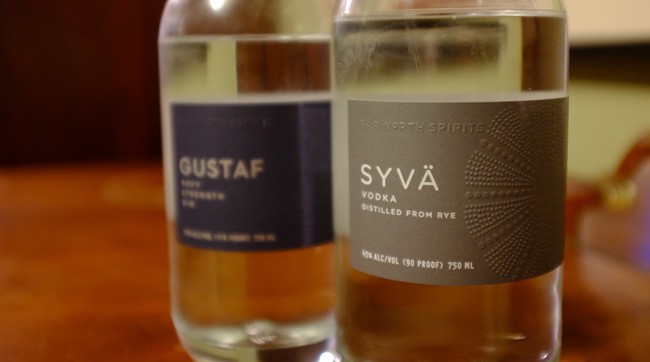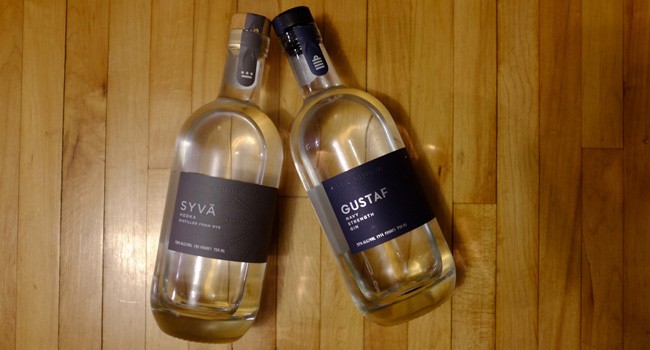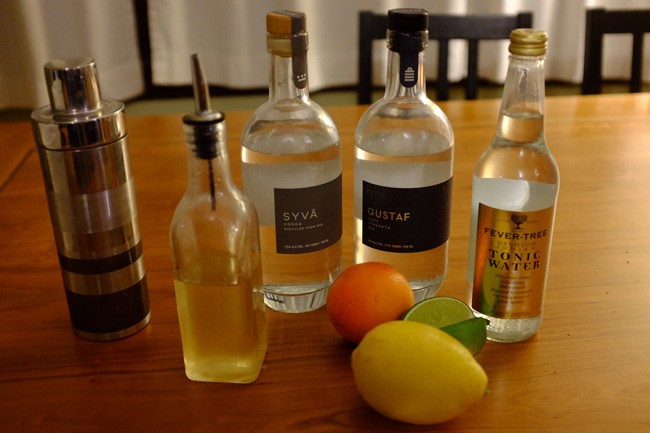
As the Minnesota distilling boom leaves its infancy, its personality is starting to sprout. Gin is proving important, a spruce-tinted spirit echoing our place among the pristine pines. A group of aquavits have shown themselves to be more than merely a regional Scandinavian quirk. And local grains, like Minnesota 13 corn, have helped define the backbone of local booze.
The man with perhaps the most distinctive distilling harvest in the state is Michael Swanson of Far North Spirits. His rye farm near Hallock provides the base for his pillowy Solveig gin. New in stores this week are the second and third spirits from that same 100-percent rye mash: Syvä [pronounced SEA-va by Far North] vodka and Gustaf Navy Strength gin.
We got the lowdown from Ian Lowther, the Far North brand ambassador and current Red Cow barman: “It’s the same distillation that we do for Solveig. Syvä is diluted down to 90 proof and charcoal filtered to make it just a touch smoother. There’s nothing else added to it; it’s just that. Super simple. Lots of vanilla and some butterscotch notes to it. Very full bodied. It’s a sipping vodka.”

Syvä is remarkably well-rounded, even creamy on the palate. Lowther wasn’t kidding about the butterscotch — the finish begs caramel, though it’s not sweet, by any means. It’s exceptional with a finer quinine; Q Tonic, Jack Rudy or Fever Tree should do the trick. Plus, when you’re calling for a regular old vodka-tonic, how much more fun is it to say “Syvä and Fever”?
Gustaf is named after the Swanson family’s rye-growing patriarch of a century ago. “Navy Strength” refers to the minimum proof once required of spirit for British sailors (they could spill a 114-proof gin on gunpowder, and it would still ignite). It’s powerful and pliable — a worthy cross to the jaw of juniper flavor.
Gustaf is more akin to classic London Dry gins than to the soft, herbal-citrus profile of Solveig. It’s an important spirit for Far North because Solveig was never well suited to a gin and tonic, being too delicate for a brash summer sip. This gin is Far North keeping its chin up.
“There are 11 botanicals in Gustaf,” says Lowther, “including Meyer lemon, grains of paradise, fennel, coriander, angelica, some cucumber in there, plus a little thyme. And there’s meadowsweet — that’s a little more esoteric of a botanical. It’s known for tasting like almond and mint, so it has this richness — the fatness — you’d get from an almond, and the menthol adds a cooling effect.”
He recommends using Gustaf in any classic gin cocktail: gimlets, negronis, martinis, and the like. Make sure to shake or stir well to compensate for the higher-proof spirit. That, or adjust your mixers accordingly.
We dig Lowther’s current take on the Old-Fashioned. For a normally burly cocktail, Gustaf holds its own.

Gustaf Old Fashioned
2⅓ oz. Gustaf Navy Strength gin
⅓ oz. coriander simple syrup*
A few dashes citrus bitters, dealer’s choice (lemon tree, bolivar, orange, etc.)
Shake vigorously with ice for 15 seconds, and strain into a fresh lowball glass with one or two large ice cubes. Garnish (or don’t) with a wide swath of orange or lemon zest.
*Coriander simple syrup: make a 2:1 simple syrup and remove from the heat. Lightly crush some whole coriander seeds (1 or 2 tablespoons per cup of syrup), and toast them in a dry saute pan until fragrant. Steep coriander in the warm syrup for at least 30 minutes before straining.
Correction: The article has been change to reflect the correct spelling of Syvä. the original text had this spelling: Syvå.


Hi Andrew,
Before I started making gin, I always had my Old Fashioned’s with rye, sometimes with bourbon. But a little over a year ago, I found this little gem. Turns out that way back in 1833, Sir J.E. Alexander describes on page 299 of his “Transatlantic Sketches” the cocktail that would later be referred to as an Old Fashioned. Actually he spends a good part of page 299 commenting on the unfortunate state of the typical New Yorker’s health, but towards the bottom of the page he moves on to the drinks. The cocktail was made for him in New York City, and was “…composed of water, with the addition of rum, gin, or brandy, as one chooses – a third of the spirit to two-thirds of the water; add bitters, and enrich with sugar and nutmeg.”
Haven’t tried it with the nutmeg – not sure how that would go with gin – but in any case, enjoy!
Skål!